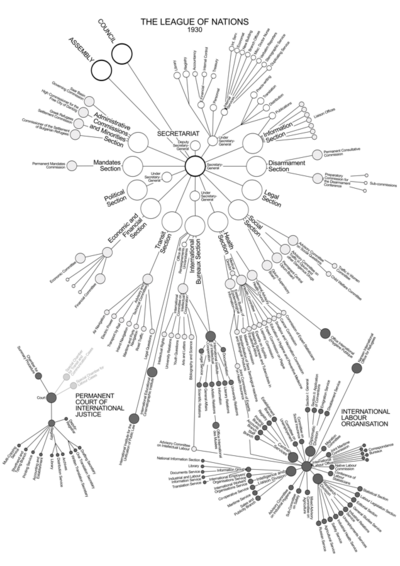Organization:International Office of Public Hygiene
Template:Infobox Former International Organization
The International Office of Public Hygiene (OIPH), also known by its French name as the Office International d'Hygiène Publique (OIHP), was an international organization founded 9 December 1907 and based in Paris, France .[1] It merged into the World Health Organization after World War II.[2][3]
History
It was created to oversee international rules regarding the quarantining of ships and ports to prevent the spread of plague and cholera, and to administer other public health conventions,[4] leading to engage on other epidemics, and the collection of broader epidemiological data on various diseases, as well as issues such as the control of medicinal opium, cannabis, and other drugs,[5] the traumas created by World War I, etc.[4]
The OIHP was part of the complex structure known as the Health Organization (Organisation d'Hygiène) of the League of Nations,[6] in an often-competing, and sometimes collaborative relation with the League of Nations' Health Committee.[7]
The OIHP was dissolved by protocols signed 22 July 1946[8] and its epidemiological service was incorporated into the Interim Commission of the World Health Organization on 1 January 1947. However, the OIHP remained in existence legally until 1952.

Organisation
The OIHP was managed by a "Permanent Committee" chaired successively by Rocco Santoliquido (1908-1919), Oscar Velghe (1919-1932), George S. Buchanan (1932-1936).[10][11][12] Important personalities were taking part in the work of the OIHP such as Camille Barrère.
As of 1933, the OIHP was composed of the following contracting parties:[10]
 Argentina, 1910
Argentina, 1910 Australia, 1909
Australia, 1909 Belgian Congo, 1927
Belgian Congo, 1927 Belgium, 1907
Belgium, 1907 Bolivia, 1912
Bolivia, 1912 Brazil, 1907
Brazil, 1907 UK British dominions, 1927
UK British dominions, 1927 UK British India, 1908
UK British India, 1908 Bulgaria, 1909
Bulgaria, 1909 Canada, 1910
Canada, 1910 Chile, 1912
Chile, 1912 Denmark, 1913
Denmark, 1913 Netherlands (Dutch Indies), 1925
Netherlands (Dutch Indies), 1925 Egypt, 1907
Egypt, 1907 France, 1907
France, 1907 French Algeria, 1910
French Algeria, 1910 French Equatorial Africa, 1929
French Equatorial Africa, 1929 French Indochina, 1914
French Indochina, 1914 French West Africa, 1920
French West Africa, 1920 Germany, 1928
Germany, 1928 UK (Great Britain), 1907
UK (Great Britain), 1907 Greece, 1913
Greece, 1913 Kingdom of Hejaz, 1932
Kingdom of Hejaz, 1932 Ireland (Irish Free State), 1928
Ireland (Irish Free State), 1928 Italy, 1907
Italy, 1907 Japan, 1924
Japan, 1924 Luxembourg, 1926
Luxembourg, 1926 Madagascar, 1920
Madagascar, 1920 Morocco, 1920
Morocco, 1920 Mexico, 1909
Mexico, 1909 Monaco, 1913
Monaco, 1913 Netherlands, 1907
Netherlands, 1907 Norway, 1912
Norway, 1912 New Zealand, 1924
New Zealand, 1924 Peru, 1908
Peru, 1908- Template:Country data Persia, 1909
 Poland, 1920
Poland, 1920 Portugal, 1907
Portugal, 1907 Romania, 1921
Romania, 1921 Sudan, 1926
Sudan, 1926 Sweden, 1909
Sweden, 1909 Czechoslovakia, 1922
Czechoslovakia, 1922 Union of South Africa, 1919
Union of South Africa, 1919 Spain, 1907
Spain, 1907 French protectorate of Tunisia, 1908
French protectorate of Tunisia, 1908 Turkey, 1911
Turkey, 1911 USA, 1907
USA, 1907 Soviet Union, 1926 (initially accessed as
Soviet Union, 1926 (initially accessed as  Russian Empire in 1907)
Russian Empire in 1907) Uruguay, 1913
Uruguay, 1913
See also
- International Sanitary Conferences
- League of Nations
- Hygiene
- Public health
- World Health Organization
- Camille Barrère
- Drug Supervisory Body
References
- ↑ Markel, H. (2014). "Worldly approaches to global health: 1851 to the present" (in en). Public Health 128 (2): 124–128. doi:10.1016/j.puhe.2013.08.004. PMID 24412079. https://linkinghub.elsevier.com/retrieve/pii/S0033350613002655.
- ↑ Beigbeder, Yves (2015-12-14), "Chapitre I. Les origines historiques de l'OMS", L’Organisation mondiale de la santé, International (Genève: Graduate Institute Publications): pp. 1–7, ISBN 978-2-940549-29-0, http://books.openedition.org/iheid/3966, retrieved 2022-09-06
- ↑ Johnson, Steven (2021) (in en). Extra Life (1st ed.). Riverhead Books. pp. 57–58. ISBN 978-0-525-53885-1.
- ↑ 4.0 4.1 Iriye, Akira (2002). Global Community: The Role of International Organizations in the Making of the Contemporary World. Berkeley: University of California Press. ISBN 0520231279.
- ↑ Riboulet-Zemouli, Kenzi; Ghehiouèche, Farid; Krawitz, Michael A. (2022). "Cannabis amnesia – Indian hemp parley at the Office International d'Hygiène Publique in 1935". doi:10.22541/au.165237542.24089054/v1. https://www.researchgate.net/publication/360540702.
- ↑ "The International Health Organization Of The League Of Nations". The British Medical Journal 1 (3302): 672–675. 1924. ISSN 0007-1447. https://www.jstor.org/stable/20436330.
- ↑ Howard-Jones, Norman (1979). International public health between the two world wars : the organizational problems. Geneva: World Health Organization. ISBN 9241560584. https://apps.who.int/iris/handle/10665/39249.
- ↑ "Protocol concerning the Office international d'hygiène publique; New York, 22 July 1946" (in EN). https://treaties.un.org/pages/ViewDetails.aspx?src=TREATY&mtdsg_no=IX-2&chapter=9&clang=_en.
- ↑ Grandjean, Martin (2017). "Complex structures and international organizations". Memoria e Ricerca (2): 371–393. doi:10.14647/87204. https://www.rivisteweb.it/doi/10.14647/87204. Retrieved 31 October 2017.
- ↑ 10.0 10.1 Office international d'Hygiène publique (1933) (in French). Vingt-cinq ans d'activité de l'Office international d'Hygiène publique (1909-1933). Paris: Office international d'hygiène publique. https://www.who.int/library/collections/publique_hygiene_1909_1933.pdf.
- ↑ "Sir George Buchanan, C.B" (in en). Nature 133 (3355): 242. 1934-02-01. doi:10.1038/133242a0. ISSN 1476-4687. Bibcode: 1934Natur.133Q.242..
- ↑ "Sir George Seaton Buchanan | RCP Museum". https://history.rcplondon.ac.uk/inspiring-physicians/sir-george-seaton-buchanan.
 |

